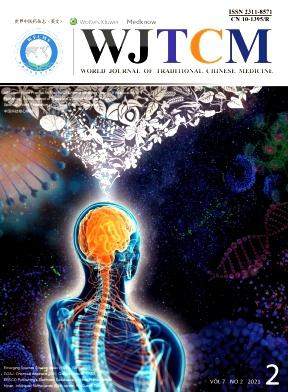Relaxant effect of bioactive component compatibility of San-ao decoction on In vitro guinea pig airway smooth muscle: A dose-response relationship study
IF 3.2
3区 医学
Q1 INTEGRATIVE & COMPLEMENTARY MEDICINE
引用次数: 1
Abstract
Background: Component compatibility is important to the modernization of traditional Chinese medicine. Studies have shown that San-ao decoction (SAD) can treat respiratory diseases by relaxing airway smooth muscle (ASM) and reducing airway hyper-responsiveness. However, whether its bioactive components and compatibility also present with similar relaxant effects remains unknown. This study aims to explore the potential relaxant property, dose-response relationship, and underlying mechanisms of the bioactive component compatibility in SAD. Methods: Network pharmacology was primarily used to identify the bioactive components of SAD and uncover its underlying mechanisms. ASM tension force measuring technique was utilized to verify the relaxant and dose-response effects on in vitro guinea pig ASM. Results: We postulated pseudoephedrine hydrochloride (PH), amygdalin (AM), and diammonium glycyrrhizate (DG) to be the bioactive components of SAD, which could effectively relax ASM in a dose-dependent manner on both acetylcholine-induced and spontaneous contraction. Both PH and AM could lead to DG dose–response curve shift. The regression equation of these three bioactive components was Y = −2.048 × X1 + 0.411 × X2 + 14.052 × X3 (X1, X2, X3 representing PH, AM, and DG, respectively). The underlying mechanisms of these components might be associated with the regulation of smooth muscle contraction. Conclusions: PH, AM, and DG are the bioactive components of SAD, which can relax ASM in a dose–response manner and exert a synergistic effect. Clinically, compatibility of these three bioactive components may serve as a new complementary and alternative treatment for respiratory diseases.三澳汤生物活性成分配伍对体外豚鼠气道平滑肌舒张作用的量效关系研究
背景:中药配伍对中药现代化具有重要意义。研究表明,三奥汤可通过放松气道平滑肌、降低气道高反应性来治疗呼吸道疾病。然而,其生物活性成分和兼容性是否也具有类似的松弛作用仍然未知。本研究旨在探讨SAD中生物活性成分相容性的潜在松弛特性、剂量-反应关系和潜在机制。方法:主要采用网络药理学方法鉴定SAD的生物活性成分,揭示其潜在机制。利用ASM张力测量技术验证了ASM对体外豚鼠ASM的松弛作用和剂量反应效应。结果:我们推测盐酸伪麻黄碱(PH)、苦杏仁苷(AM)和甘草酸二铵(DG)是SAD的生物活性成分,它们对乙酰胆碱诱导的和自发的收缩都能以剂量依赖的方式有效地放松ASM。PH和AM都可能导致DG剂量-反应曲线的偏移。这三种生物活性成分的回归方程为Y=−2.048×X1+0.411×X2+14.052×X3(X1、X2、X3分别代表PH、AM和DG)。这些成分的潜在机制可能与平滑肌收缩的调节有关。结论:PH、AM和DG是SAD的生物活性成分,它们可以以剂量-反应的方式放松ASM并发挥协同作用。临床上,这三种生物活性成分的兼容性可能成为呼吸系统疾病的一种新的补充和替代治疗方法。
本文章由计算机程序翻译,如有差异,请以英文原文为准。
求助全文
约1分钟内获得全文
求助全文
来源期刊

World Journal of Traditional Chinese Medicine
Medicine-Complementary and Alternative Medicine
CiteScore
5.40
自引率
2.30%
发文量
259
审稿时长
24 weeks
 求助内容:
求助内容: 应助结果提醒方式:
应助结果提醒方式:


